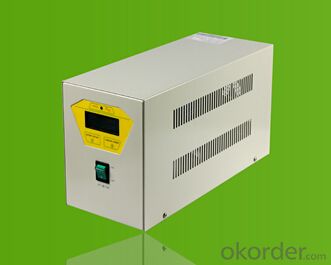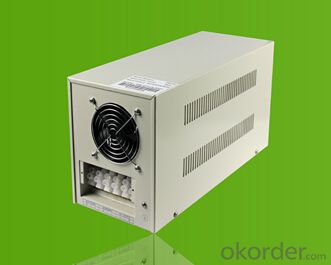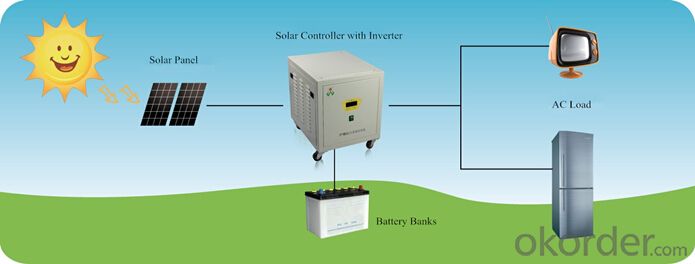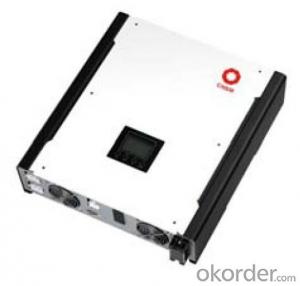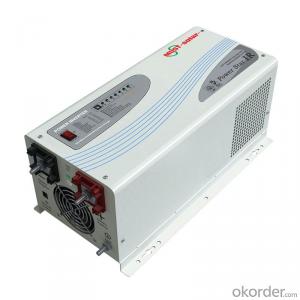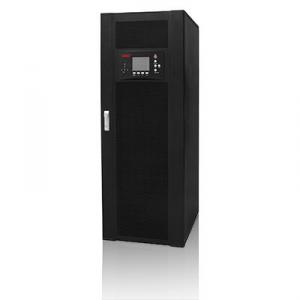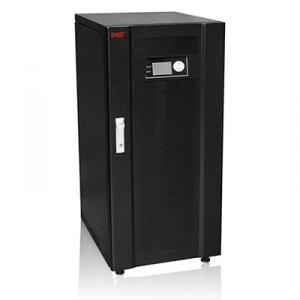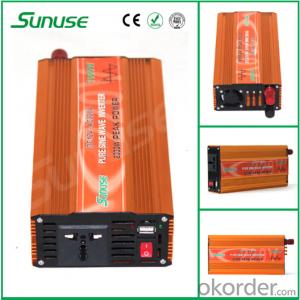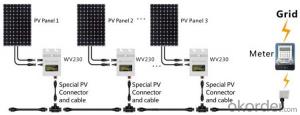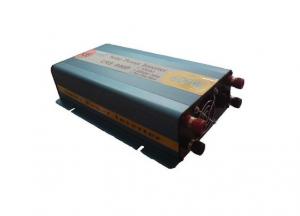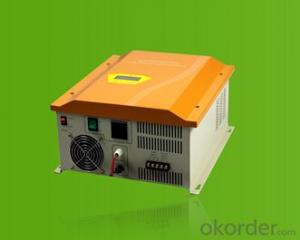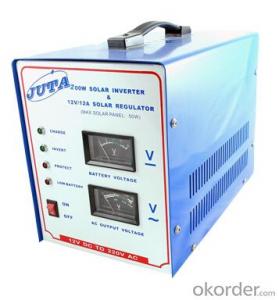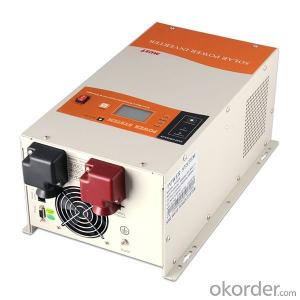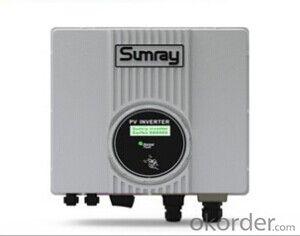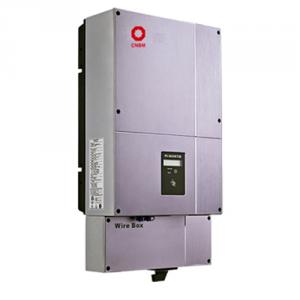16 Kw Solar Inverter with Solar Controller and Inverter 600W-1000W
- Loading Port:
- Shanghai
- Payment Terms:
- TT OR LC
- Min Order Qty:
- 1 unit
- Supply Capability:
- 8000 unit/month
OKorder Service Pledge
OKorder Financial Service
You Might Also Like
I. PRODUCT INTRODUCTION
Solar controller with inverter is the intelligent power supply with integration of solar and DC to AV inverse. The apparatus is mainly used for solar power system; provide effective power for traffic inconvenience, the harsh environment of the mountain area, a pasturing area, border, islands and other areas without electricity. With decent appearance, easy operation, and visual indication of LCD, the apparatus has perfect protection function, high charging efficiency, and low no-load loss.
II. APPLICATION AREAS
Photovoltaic power station
Domestic household photovoltaic power system
Coastal islands, remote mountainous, border posts for regions shortage of or without electricity.
Government demonstration projects, landscape lighting projects, etc.
Mobile communication base station, expressway and other non-residential regions.
III. 600W-1KW TECHNICAL PARAMETERS
Product Model | WSI0606-24 | WSI1010-24 | WSI1010-48 |
Rated solar power | 600 W | 1000 W | 1000 W |
Floating charging voltage | 29 V | 29 V | 58 V |
Rated inverter output capacity | 600 VA | 1000 VA | 1000 VA |
Rated battery voltage | 24 V | 24 V | 48 V |
Over voltage shutoff | 34 V | 34 V | 68 V |
Over voltage recovery | 33 V | 33 V | 66 V |
Battery over-discharge shutoff | 21.6 V | 21.6 V | 43.2 V |
Battery over-discharge recovery | 24 V | 24 V | 48 V |
No-load loss current | ≤0.7 A | ≤0.7 A | ≤0.5 A |
Net weight | 10 kg | 12 kg | 12 kg |
Dimension | 402×163×202 mm | ||
Output wave | Pure sine wave | ||
Display mode | LCD | ||
Cooling | Fan | ||
Rated output voltage | 110/120/220/230/240 VAC | ||
Wave Distortion | ≤4% | ||
Output Frequency | 50/60±0.5 Hz | ||
Dynamic Response | 5% | ||
Power Factor | ≥0.8 | ||
Over-load Capacity | 120% 1min, 150% 10s | ||
Inverter Efficiency | Maximum 90% | ||
Isolating Mode | Frequency Toroidal Transformer | ||
Protection Level | IP20(Indoor) | ||
Noise (1m) | ≤40dB | ||
Insulating Strength | 1500VAC, 1min | ||
Protection Functions | Inverter input over-voltage protection; battery over-discharge protection; battery anti-reverse-connection protection; output over-load protection; output short circuit protection; overheating protection | ||
Ambient Temperature | -20~+55℃ | ||
Ambient Humidity | 0~93%, without condensing | ||
Working Altitude | ≤4000m | ||
In order to serve our customers better. Our company can adjust parameters configuration according to customer’s requirement. | |||
IV. APPENDIX
Optional Functions | |
Ø By-pass Function: It will switch to the city grid automatically when the battery is under voltage, which ensures the continuity and stability of system. | |
Ø English display function: It can display in English. | |
Friendly reminder: customers should provide the following information when ordering Solar Controller with Inverter | |
Ø Rated battery voltage | Ø Load power and load characteristics |
Ø Rated solar panel power | Ø Inverter output capacity |
Ø With or without by-pass function | Ø Rated output voltage and rated output frequency |
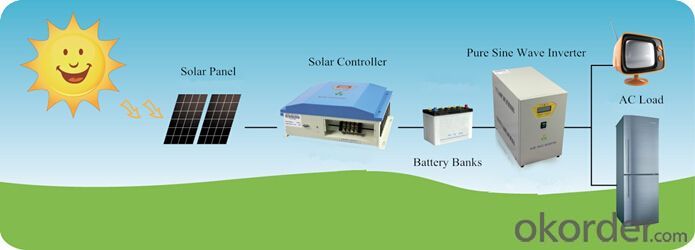
- Q: How do you connect a solar inverter to a data monitoring system?
- To connect a solar inverter to a data monitoring system, you need to follow a few steps. First, ensure that your inverter is compatible with the data monitoring system you intend to use. Then, connect the inverter to your local network using an Ethernet cable or wireless connection. Next, access the inverter's settings through a web interface or mobile app and enable data monitoring. Finally, input the necessary information, such as IP addresses or log-in credentials, into the data monitoring system to establish the connection between the inverter and the monitoring platform.
- Q: How does a solar inverter affect the overall system cost?
- A solar inverter can increase the overall system cost as it is a crucial component responsible for converting the DC electricity generated by solar panels into AC electricity for use in homes and businesses. The efficiency, capacity, and quality of the inverter can influence the system's performance and reliability. Higher-quality inverters with advanced features tend to be more expensive, but they can maximize energy production and improve system durability, potentially offsetting the initial cost through increased energy savings over time.
- Q: Can a solar inverter be upgraded or expanded?
- Yes, a solar inverter can be upgraded or expanded. Upgrades can involve increasing the capacity or efficiency of the existing inverter, while expansion typically refers to adding more inverters to the system to accommodate additional solar panels or increase the overall energy output. However, it is important to consult with a professional to ensure compatibility and proper integration with the existing solar power system.
- Q: Can a solar inverter be used with different types of solar panels?
- Yes, a solar inverter can typically be used with different types of solar panels. Solar inverters are designed to convert the direct current (DC) generated by solar panels into alternating current (AC) that can be used to power various electrical devices. As long as the solar panels produce compatible DC voltage and current, they can be connected to the solar inverter regardless of their type, such as monocrystalline, polycrystalline, or thin-film panels. However, it is important to ensure that the solar inverter is appropriately sized and compatible with the total capacity of the connected solar panels for optimal performance.
- Q: Can a solar inverter be used in a multi-string configuration?
- Yes, a solar inverter can be used in a multi-string configuration. In fact, many modern solar inverters are designed to handle multiple strings of solar panels. This configuration allows for more flexibility in system design and improves overall performance and efficiency of the solar power system.
- Q: Can a solar inverter be easily integrated into an existing electrical system?
- Yes, a solar inverter can be easily integrated into an existing electrical system. It can be connected to the main electrical panel to convert the DC power generated by solar panels into AC power that can be used to power appliances and devices in the building. However, it is important to consult with a professional electrician to ensure proper installation and compatibility with the existing system.
- Q: What is the difference between low voltage grid connection and medium voltage grid connection?
- The difference is that the current at low voltage and the grid is large, the current is small when the voltage is small, followed by the low voltage crossing parameter setting problem (such as PV inverter integrated with inverter and low voltage crossing function, not all photovoltaic inverter
- Q: What is the role of a voltage control unit in a solar inverter?
- The role of a voltage control unit in a solar inverter is to regulate and stabilize the voltage of the direct current (DC) power generated by the solar panels before it is converted into alternating current (AC) power. It ensures that the voltage remains within the desired range to optimize the efficiency and performance of the solar inverter, as well as protect the connected appliances or grid from potential damage due to voltage fluctuations.
- Q: What is the role of a power control unit in a solar inverter?
- The role of a power control unit in a solar inverter is to regulate and control the flow of electricity between the solar panels and the grid. It ensures maximum power output from the solar panels by optimizing their performance and matching it with the electrical requirements of the grid. Additionally, it provides protection against overvoltage, overcurrent, and other electrical faults to ensure safe and efficient operation of the solar inverter system.
- Q: How does a solar inverter handle voltage fluctuations during grid disturbances?
- A solar inverter handles voltage fluctuations during grid disturbances by continuously monitoring the grid voltage. When a disturbance occurs, such as a sudden drop or increase in voltage, the inverter's control system detects it and adjusts the output voltage accordingly. This allows the inverter to stabilize the voltage and ensure a consistent supply of electricity to the connected solar panels or the grid.
Send your message to us
16 Kw Solar Inverter with Solar Controller and Inverter 600W-1000W
- Loading Port:
- Shanghai
- Payment Terms:
- TT OR LC
- Min Order Qty:
- 1 unit
- Supply Capability:
- 8000 unit/month
OKorder Service Pledge
OKorder Financial Service
Similar products
Hot products
Hot Searches
Related keywords



